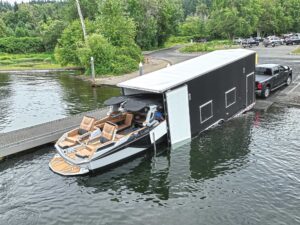Overview
Sea-Doo is no stranger to recognizing a popular trend, not just in the personal watercraft category, but also in the boating market as a whole. The Wake series has long catered to the watersports enthusiast at a fraction of the price of a dedicated tow-sports boat. More recently, a trio of Fish Pro models did likewise, targeting the recreational fish crowd and offering amenities that could even satisfy some hardcore anglers. What’s next? Citing the increased popularity of camping and “adventure-based” activities, along with the fact that consumers rank the ability to explore and access new areas as one of the main reasons they buy a PWC, the company debuted an Adventure category for 2023. Its current lone occupant is the Explorer Pro 170, a craft that can go farther, haul more gear, and push typical riding conditions—and riding seasons—farther than ever before.
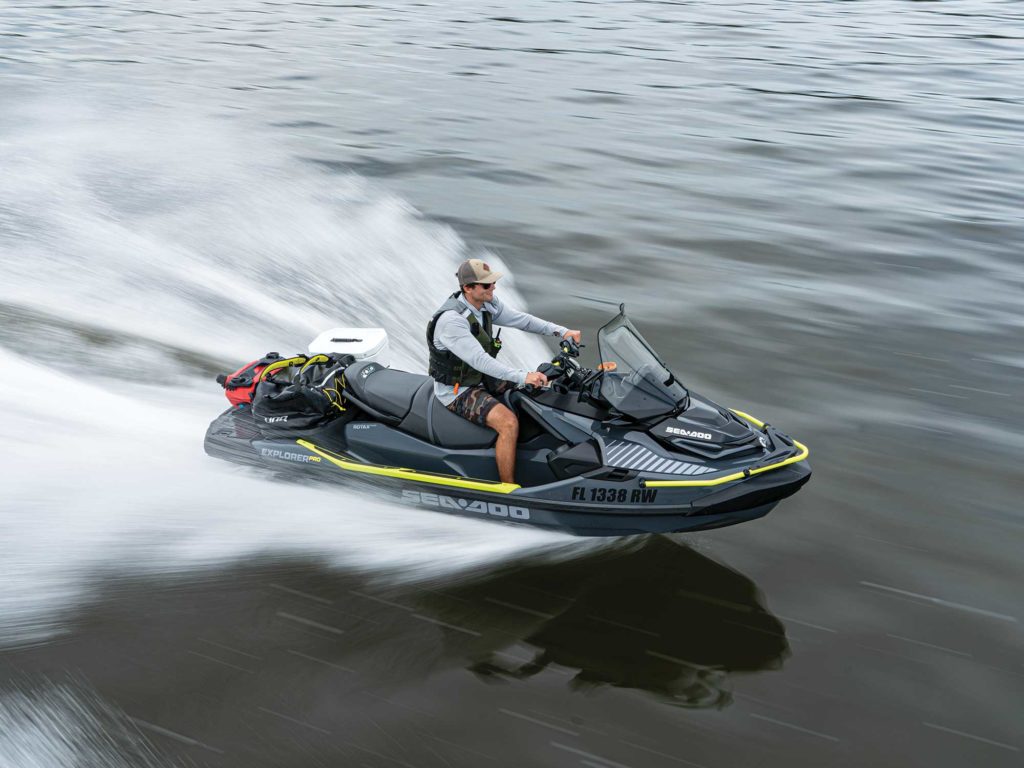
Extras and Accessories
Sea-Doo bases the Explorer Pro off of the GTX 170, adding an adventure-worthy list of extras. The most obvious sits right in front of your face. The Explorer Pro is the first production PWC in the market’s 56-year history to feature a windshield. The design funnels airflow up and over the rider to reduce fatigue caused by prolonged wind pressure and noise while offering shelter from the elements. Over the course of a two-day touring ride, I indeed noted a quieter, drier ride and appreciated the ability to tuck behind the windshield to avoid spray and rain. A windshield will arguably be a game-changer for riders who extend their riding season into cooler months or prefer not to run to shore when rain moves in. Still, I wasn’t completely sold. The top of the windshield’s black-trimmed frame fell directly into this average-height guy’s line of vision, forcing me to either sit extra tall in the saddle to see over the top or slump to see below. An alternate set (or two) of mounting holes would tailor the windshield’s position to a wider variety of riders. There’s also a slight distortion to the polycarbonate that can make it harder to read oncoming water. However, put me in a colder climate or driving rain and I’d take its protection all day long.
Storage potential may be the Explorer’s greatest strength. A new 1-foot-8-inch-deep Multi-Cargo Rack tops much of the existing aft platform, adding three sets of Sea-Doo’s LinQ attachment points to easily secure accessories, from coolers to storage options. The addition of a 1-foot-3-inch rear deck extension adds an additional 11.5 inches beyond the standard GTX platform along with three more sets of LinQ mounts. The sizable platform makes it realistic to haul an abundance of gear. On our run down the Florida Intracoastal Waterway, we stashed gear bags in the spacious front storage, stored items like food, a tent and a cooking stove on platform-mounted caddies, and even had room for extra fuel. Fill the platform with five fuel caddies and you double the craft’s range. Be aware, however, that fully loading the aft platform can affect handling, an issue that intensifies as the bow lightens with fuel consumption. It wasn’t much of an issue in open water, but the bow repeatedly wandered in a group setting in narrow confines as it got caught up in the wakes of riders ahead. A set of fixed tabs would elongate the running surface and possibly help. Perhaps the aftermarket will respond.
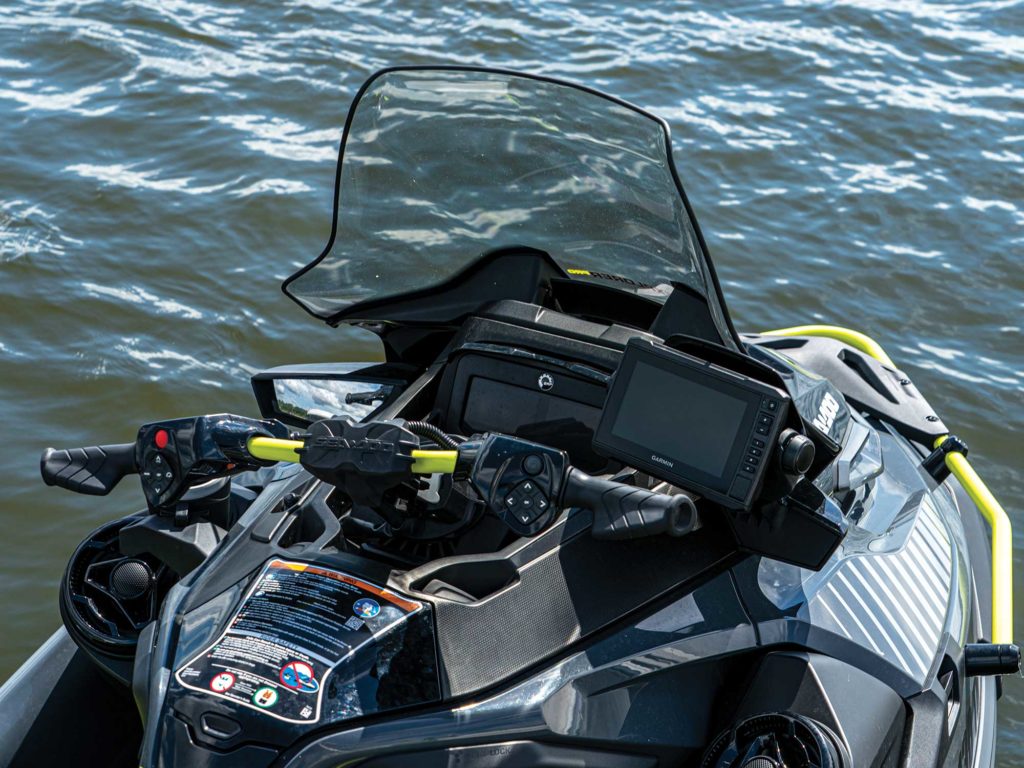
Additional features complement the Explorer’s adventure and touring focus. Riders who like to occasionally stand, especially in rougher waters, will appreciate an adjustable handlebar riser that can add up to 3 inches to the handlebar’s height and allow for a more comfortable, upright posture. A 7-inch Garmin touchscreen GPS proves valuable, whether exploring a completely new area or just looking for the next channel marker in open waterways. Gunwale footrests provide added comfort when sitting sideways on the saddle or stepping aboard. A neon-yellow bumper, in actuality more of an extra-sturdy bow rail, makes it easier to pull the craft onto shore when beaching. Sea-Doo’s popular Bluetooth audio system is also included on the Explorer Pro, as is the Intelligent Debris Free pump system that offers push-button flushing of the jet pump, ideal when exploring waters that may not always be free of debris.
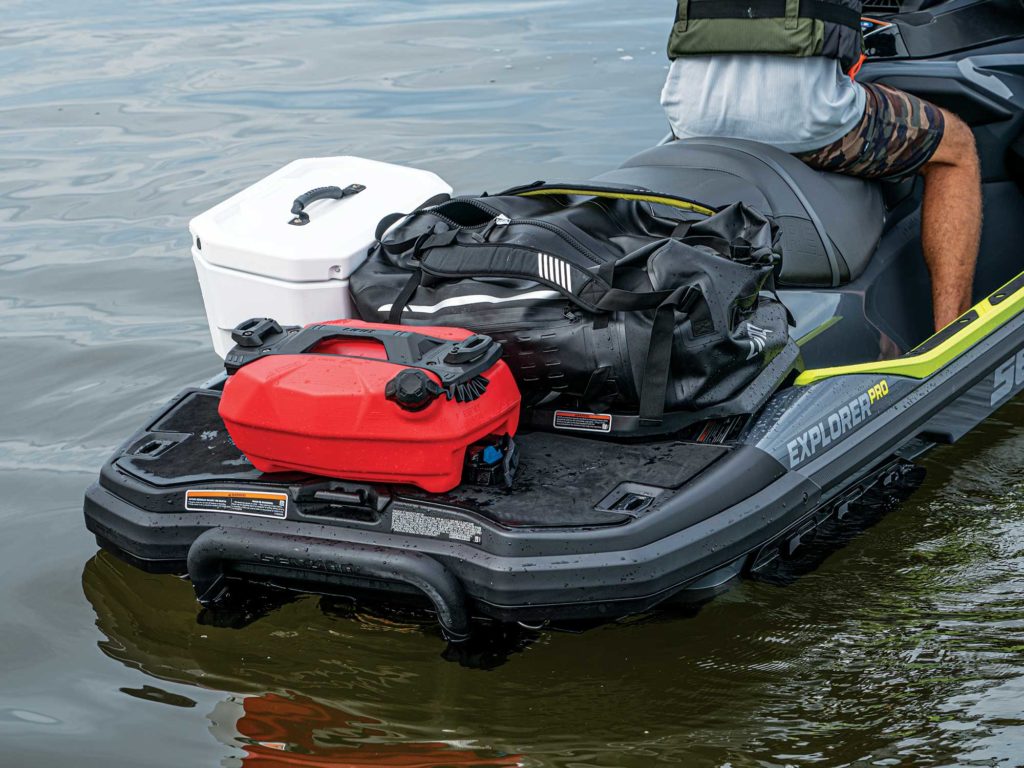
Engine
As to the hull-and-engine combo below the Adventure-category trappings, it serves the purpose well. The GTX is Sea-Doo’s flagship three-passenger platform, with a deep 23-degree deadrise hull that can tame rougher waters while still offering a comfortable ride and exceptional overall stability underway and at rest. With a 170 hp Rotax 1630 ACE engine and freed from its excess gear, it can accelerate strongly out of the hole and carve an aggressive turn with flair. As you might expect with the added platform and weight, top speed suffers slightly (expect about 52 mph). But that shouldn’t be much of a concern to a target audience that prioritizes how far it can go over how fast it can get there.
Though no competitor offers a craft this focused, Yamaha’s FX HO can be outfitted with a 6-inch Garmin GPS package and the RecDeck, a 6-foot-square accessory platform with mounts to accommodate accessories like coolers and storage caddies, for $17,868. However, for the true adventure and touring rider, the Explorer Pro simply offers more overall for less. And it throws in a windshield to boot.
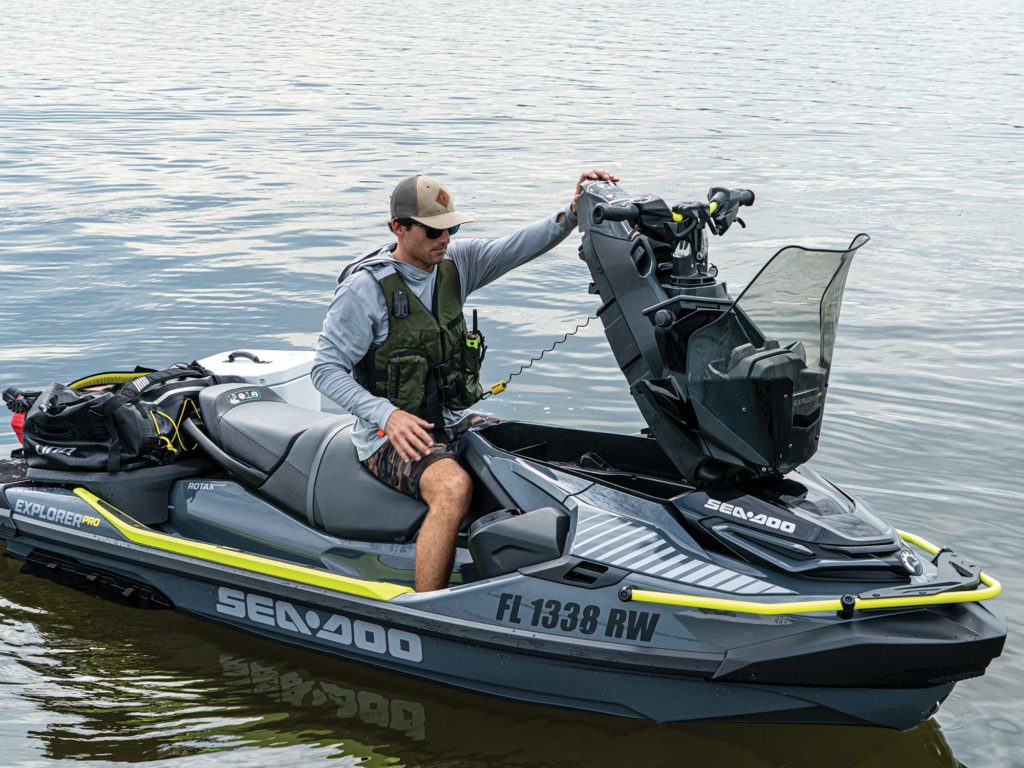
How We Tested
- Engine: 170 hp Rotax 1630
- ACE Pump/Impeller: 155 mm high-pressure pump with stainless-steel impeller
- Gear Ratio: 1.00:1 Fuel Load: 18 gal. Crew Weight: 155 lb.
High Points
- Windshield removes easily with hand tools for those times—like a Florida summer—when you welcome the breeze and spray.
- Count the 26.4-gallon LinQ Explorer Dry Bag as your first platform accessory. It’s standard and can be carried on and off the craft like a backpack.
- Windshield slides 2 inches forward with minimal pressure, breaks free, and hinges totally forward with impact to prevent injury.
Low Points
- Exceptionally dark color scheme has only the briefest neon accents, making for a craft that is not highly visible out on the water.
- Vent system at the base of the windshield could be larger. On a hot summer day, more fresh air would be welcome.
- LinQ accessories truly complete the boat but significantly add to the overall price.
Pricing and Specs
| Price: | $16,799 |
| LOA: | 12’3″ |
| Beam: | 4’1″ |
| Draft: | 11″ |
| Displacement: | 859 lb. |
| Fuel Capacity: | 18.5 gal. |
| Passenger/Weight Capacity: | 3/600 lb. |
| Stowage Capacity: | 52.3 gal. |
Speed, Efficiency, Operation
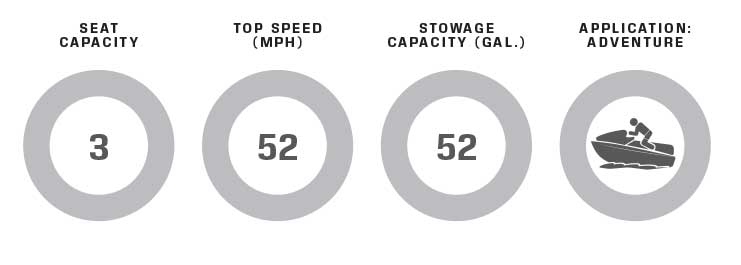
Sea-Doo – Valcourt, Quebec; 888-272–9222; sea-doo.com

